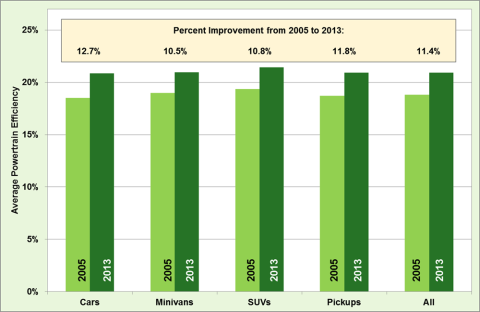Powertrain efficiency in a recent study was defined as the ratio of tractive work (integrated power) needed for a vehicle to complete a drive cycle divided by the fuel energy consumed. In short, this is a measure of how good the powertrain is at getting fuel energy to the road. Many cars have a fuel economy advantage over light trucks due to weight and aerodynamics, but there is not a lot of difference in the powertrain efficiencies by vehicle class.
Much of the improvement in conventional vehicle fuel economy over the last few years is due to the vehicle powertrains becoming more efficient. A recent study compared powertrain efficiency for 37 pairs of same-model vehicles for MY2005 and MY2013. The vehicle pairs: (1) included many of the most-popular models sold; (2) had the same vehicle model name in MY2005 & MY2013; (3) had the same or greater horsepower for the MY2013 version; and (4) had similar vehicle weight. The values for powertrain efficiency for the 2013 vehicles were compared to their 2005 counterparts. Results from the individual vehicles ranged from no improvement for a few vehicles (where the powertrain was relatively unchanged) to improvement up to 28%. When the data are averaged by vehicle type, the cars in the study had a 12.7% improvement (from 18.5% efficiency to 20.9% efficiency) and the pickup trucks had an 11.8% improvement. The average improvement of all 37 vehicle pairs was 11.4%.
Average Powertrain Efficiency by Vehicle Type for Selected 2005 and 2013 Vehicles
Notes:
Data includes only conventional vehicle pairs. Eighteen pairs were cars; two pairs were minivans; twelve pairs were sport-utility vehicles (SUVs); and five pairs were pickup trucks.
Supporting Information
| Vehicle Type | Average 2005 powertrain efficiency | Average 2013 powertrain efficiency |
|---|---|---|
| Cars | 18.5% | 20.9% |
| Minivans | 19.0% | 21.0% |
| SUVs | 19.4% | 21.4% |
| Pickups | 18.7% | 20.9% |
| All | 18.8% | 20.9% |
Source: Thomas, J., "Drive Cycle Powertrain Efficiencies and Trends Derived from EPA Vehicle Dynamometer Results," SAE Int. J. Passeng. Cars - Mech. Syst. 7(4):2014, doi:10.4271/2014-01-2562. SAE 2014 International Powertrain, Fuels & Lubricants Meeting, October 20-23, 2014, Birmingham, UK. Based on data from the Environmental Protection Agency, Light-Duty Automotive Technology, Carbon Dioxide Emissions, and Fuel Economy Trends database. | ||


